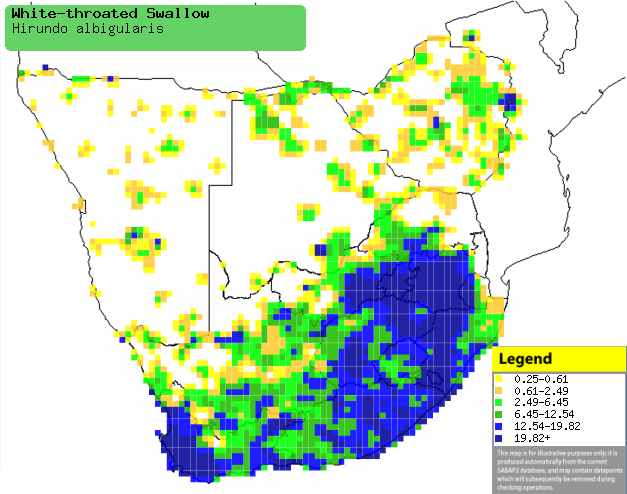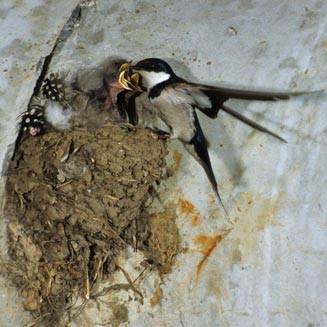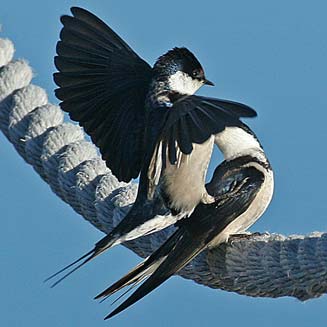Hirundo albigularis (White-throated
swallow)
Witkeelswael [Afrikaans]; Inkonjane (generic term for
swallows) [Xhosa]; iNkonjane (generic term for swallows) [Zulu]; Sisampamema
(generic term for swallows, martins, swifts and spinetails) [Kwangali];
Lefokotsane (generic term for swallow), ’Malinakana, Lekabelane [South Sotho];
Nyenganyenga (generic name for swallow or martin) [Shona]; Mbawulwana, Nyenga
(generic term for swallow) [Tsonga]; Pêolwane, Phêtla (generic terms for
swifts, martins and swallows) [Tswana]; Witkeelzwaluw [Dutch]; Hirondelle à
gorge blanche [French]; Weißkehlschwalbe [German]; Andorinha-de-garganta-branca
[Portuguese]
Life
> Eukaryotes >
Opisthokonta
> Metazoa (animals) >
Bilateria >
Deuterostomia > Chordata >
Craniata > Vertebrata (vertebrates) > Gnathostomata (jawed
vertebrates) > Teleostomi (teleost fish) > Osteichthyes (bony fish) > Class:
Sarcopterygii (lobe-finned
fish) > Stegocephalia (terrestrial
vertebrates) > Tetrapoda
(four-legged vertebrates) > Reptiliomorpha > Amniota >
Reptilia (reptiles) >
Romeriida > Diapsida > Archosauromorpha > Archosauria >
Dinosauria
(dinosaurs) > Saurischia > Theropoda (bipedal predatory dinosaurs) >
Coelurosauria > Maniraptora > Aves
(birds) > Order: Passeriformes
> Family: Hirundinidae
Distribution and habitat
Occurs from southern DRC, Angola and Zambia to southern
Africa. In this region the bulk of Its population lies in South Africa,
Swaziland and Lesotho, with scattered populations in Zimbabwe, Botswana and
Namibia. It can be found in a wide variety of habitats, but it generally favours
open grassland, fynbos and mountainous regions, especially near water.
|
 |
|
Distribution of White-throated swallow in southern
Africa, based on statistical smoothing of the records from first SA Bird
Atlas Project (©
Animal Demography unit, University of
Cape Town; smoothing by Birgit Erni and Francesca Little). Colours range
from dark blue (most common) through to yellow (least common).
See here for the latest distribution
from the SABAP2. |
Predators and parasites
It has been recorded as prey of
Polyboroides typus (African
harrier-hawk, Gymnogene)
Brood parasites
It has been recorded as host of the
Lesser honeyguide.
Movements and migrations
Intra-African breeding migrant, arriving in
southern Africa during July-September and leaving around April-May
in flocks of 20-1000 birds. Its non-breeding grounds are reportedly
in Angola, Zambia and southern DRC, but no ring recoveries have been
made to confirm this.
Food
It exclusively eats airborne insects, doing most of its
foraging close to the ground, hawking prey aerially. It occasionally forages on
the ground and along coastal shorelines. The following food items have been
recorded in its diet:
Breeding
- It is a monogamous, solitary nester, with one breeding pair producing
multiple broods in a single breeding season.
- The nest (see image below) is a small, open cup made of mud pellets and
lined with fine grass, rootlets, hair and feathers. It is often placed on a
vertical rock face (often under an overhang) or commonly a man-made
structure such as a water tank, bridge, dam wall or building.
 |
 |
| White-throated swallow feeding chicks at nest.
[photos Peter Steyn ©] |
White-throated swallows mating, South Africa. [photo Jim Scarff ©] |
- Egg-laying season is from August-March, peaking in October-December.
- It lays 2-5, usually 3 eggs which are incubated for 15-18 days.
- The chicks are fed by both adults, fledging after about 18-25 days, but
still roosting in the nest for at least 2 weeks.
Threats
Not threatened, in fact its range and population have
increased in the Western Cape due to the increasing availability of man-made
nest sites.
References
-
Hockey PAR, Dean WRJ and Ryan PG 2005. Roberts
- Birds of southern Africa, VIIth ed. The Trustees of the John Voelcker
Bird Book Fund, Cape Town.
|
